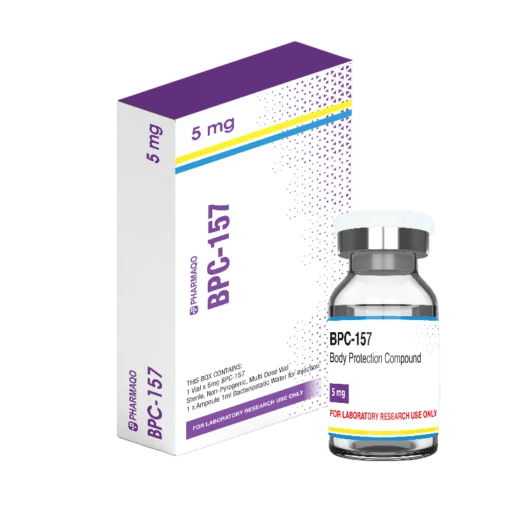If you’ve been researching peptides for recovery and healing, you’ve likely come across both BPC-157 and TB-500. While these two peptides offer similar benefits, they are not the same. Both BPC-157 and TB-500 help speed up recovery, reduce inflammation, and promote healing, but they work in different ways. In this blog, we’ll explore the differences between BPC-157 and TB-500, how they work, and which might be best for your needs.
What Is BPC-157?
BPC-157 stands for Body Protection Compound 157. It’s a synthetic peptide derived from a protein found in the human stomach. BPC-157 is well-known for its healing properties, particularly when it comes to repairing:
- Muscles
- Ligaments
- Tendons
- Joint injuries
Many people use BPC-157 to speed up recovery from injuries, reduce inflammation, and heal damage from overuse or trauma. It has also been shown to help treat gut issues like ulcers and leaky gut syndrome. BPC-157 works by promoting blood vessel growth (angiogenesis) and improving blood flow to damaged tissues, which accelerates healing.
What Is TB-500?
TB-500 is another synthetic peptide, but it is derived from Thymosin Beta-4, a protein that occurs naturally in almost all human and animal cells. TB-500 plays a role in tissue repair, cell regeneration, and inflammation reduction. Like BPC-157, it helps heal muscles, tendons, and ligaments, but it also has a broader impact on cell growth and migration.
TB-500 promotes actin-binding, a crucial process in cellular regeneration. This peptide helps improve flexibility, reduce inflammation, and speed up recovery, especially after surgery or serious injuries.
How Do BPC-157 and TB-500 Work?
Although both BPC-157 and TB-500 promote healing, they do so in different ways:
- BPC-157 works by increasing angiogenesis (the formation of new blood vessels). It helps tissues heal by improving blood flow and speeding up the body’s natural healing processes. BPC-157 targets specific areas of damage, such as tendons and ligaments.
- TB-500 promotes cell migration and regeneration, making it effective in healing various types of tissues. It interacts with actin, a protein essential for cell movement and growth. TB-500 helps reduce inflammation throughout the body, which makes it ideal for systemic healing.
Key Differences Between BPC-157 and TB-500
Although both peptides promote healing, they target different processes and offer unique benefits:
- Tissue-Specific Healing:
- BPC-157 focuses more on specific injuries, such as muscle and ligament tears. It’s great for localized healing.
- TB-500 has a more systemic effect, helping to heal across the entire body by promoting cell growth and repair.
- Inflammation Control:
- Both BPC-157 and TB-500 reduce inflammation, but TB-500 has broader anti-inflammatory effects throughout the body.
- BPC-157 is more targeted and tends to focus on healing damaged tissues directly.
- Flexibility and Mobility:
- TB-500 can help improve flexibility and mobility, especially in tendons and joints, thanks to its ability to promote cell regeneration.
- While BPC-157 enhances recovery, it doesn’t specifically target flexibility the way TB-500 does.
- Wound Healing:
- Both peptides are used for wound healing, but TB-500 is often chosen for more severe injuries or surgeries because of its systemic impact.
- BPC-157 is excellent for targeted healing, especially for muscle injuries and tendon tears.
Which Peptide Should You Choose?
Choosing between BPC-157 and TB-500 depends on your specific needs:
- If you’re dealing with localized injuries like muscle tears, tendonitis, or joint pain, BPC-157 may be the better choice. It’s highly effective for targeting specific areas and speeding up recovery.
- If you’re recovering from a surgery or have widespread inflammation, TB-500 might be more effective. Its ability to promote healing across the entire body makes it a versatile option for systemic injuries.
Some people use both peptides together to maximize their healing effects. Combining BPC-157 and TB-500 can create a synergistic effect, helping you heal faster and recover from injuries more effectively.
Can You Use BPC-157 and TB-500 Together?
Yes, many athletes, bodybuilders, and individuals recovering from injuries use both BPC-157 and TB-500 together. Since they work through different mechanisms, combining them can offer enhanced healing. You can target specific injuries with BPC-157 while using TB-500 to promote overall tissue repair and reduce systemic inflammation.
However, always consult a healthcare provider before using any peptide therapies, especially if you plan to combine them.
Safety and Side Effects
Both BPC-157 and TB-500 are generally considered safe when used appropriately. Most users report minimal side effects, especially when following recommended dosages. However, as with any peptide therapy, it’s important to monitor your body’s response.
Common side effects may include:
- Mild irritation at the injection site
- Temporary fatigue
- Possible headaches
Always consult your healthcare provider before starting any new supplement or peptide therapy, and ensure you’re sourcing your peptides from a trusted provider.
Conclusion: Are BPC-157 and TB-500 the Same?
Although BPC-157 and TB-500 both help with recovery and healing, they are not the same. BPC-157 focuses on targeted tissue repair, especially for muscles, tendons, and ligaments. TB-500, on the other hand, promotes systemic healing by encouraging cell growth and regeneration throughout the body.
If you’re looking for a solution to treat localized injuries, BPC-157 may be your best choice. For wider healing and recovery, TB-500 could offer more comprehensive benefits. And for the best results, you might consider using both together under the guidance of a healthcare professional.
For lab-tested BPC-157 and TB-500 products, visit our Pharmaqo shop. We offer high-quality peptides designed to support your recovery, no matter your fitness or health goals.
